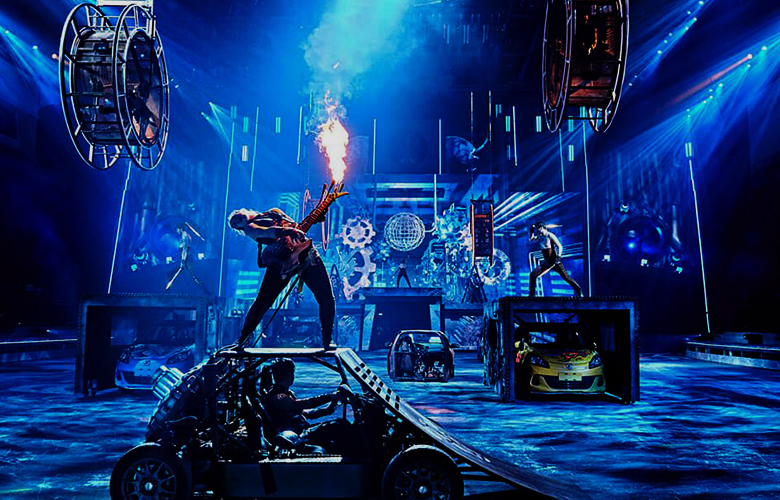
I could smell and taste the smoking, hot tires of drifting cars when I first stepped through the ELĒKRŎN stage door in November 2018. A thick, sweet, heavy scent lingered in the air. I could almost touch it. I certainly felt it. In my nostrils, mouth, and throat. A coarse, yet exhilarating sensory cocktail which quickly became the basis of my existence. The sound of screeching tires was deafening. A large part of backstage looked like a race track due to bright red plastic barriers everywhere, marking a safe path for speeding vehicles to get on- and off-stage.
I had seen the posters all over Macau, advertising “The Most Electrifying Stunt Show in The World!”. A logo depicting gleaming engine blocks. And pictures, promising a strange mix of colorful vehicles which seemed to have come straight out of Mad Max and The Fast and the Furious all at the same time…
So, it came as no surprise when the weeks leading up to the opening of our show were both fast and furious. Most of our custom-built vehicles arrived two months too late, shortening our tech and creation period to two instead of four months.
This was going to be the first ever vehicle stunt show in the world featuring only electric vehicles. We had everything you could possibly think of. Quad bikes, an assortment of buggies, a converted Mr. Bean vintage Mini, a Ford from the Eighties with an old, brown leather couch mounted onto the roof, sports cars looking like silver bullets, a black Porsche, a rickshaw, a noodle truck, FMX bikes, and sports bikes. All of them were fitted with powerful Tesla engines.
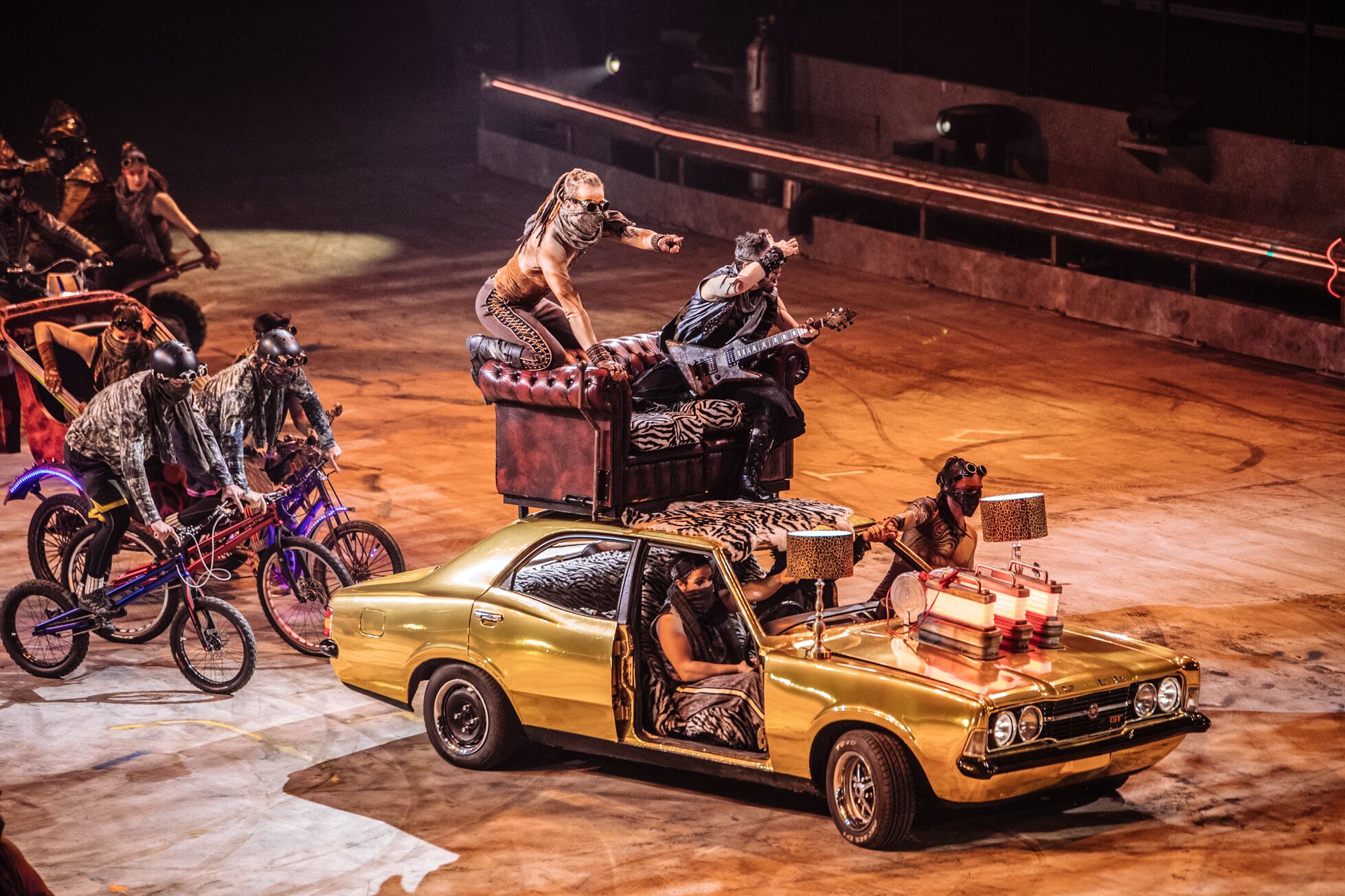
Our arena wasn’t purpose-built for this show. It had actually been a business convention venue up until we moved in. Even though the auditorium boasted 3,000 seats, the actual arena stage was rather small… especially considering that our director was planning to have up to fifteen speeding vehicles onstage at the same time. Not to mention some of the largest and heaviest props I had ever seen.
These props came in the form of cones, two old Fords leaning against each other, tall stacks of tires, etc. Some of these (altogether twenty) set pieces weighed an impossible 1.5 tons each. Meant as obstacles for motorbikes to jump over and do tricks on, they had to be built to be as solid as mountains. At first, we were asked to manually push these (predominantly) metal mountains on stage. I lost body weight and built muscle (as well as muscle inflammations and back pain) faster than I could blink. I lost fingernails and squashed my toes on a daily basis – despite wearing gloves and heavy-duty steel-toe boots at all times.
Due to injuries, we lost people left and right. Plus, the show’s budget simply didn’t allow hiring two dozen Arnold Schwarzeneggers as stage hands, only to be on stand-by as props pushers and pullers. As creation progressed, we found work-arounds. First, half of the original props were thrown away. Second, our brilliant MacGyver clone aka Head of Staging found ways to tow most massive set pieces on- and off-stage with the help of the show’s main characters: our vehicles. This meant, however, that the storyline and choreography of many scenes had to be changed radically to allow for cars to enter the stage as, essentially, tow trucks. To then morph into elegant speeding and flying flashes of shiny, classic race car metal, or turn into vehicular brutes for a more apocalyptic character, featuring skulls, bones, chains, and camo nets.
At first, vehicles malfunctioned and broke on a daily basis. Our drivers and riders were highly skilled young daredevils, but they now had to get used to driving electrical vehicles which had an entirely different weight distribution and handling compared to the cars and bikes they usually dealt with. Smaller and larger crashes during rehearsals were not unusual. Neither were vehicle parts falling off randomly due to the heavy usage our mechanical steeds weren’t necessarily built for.
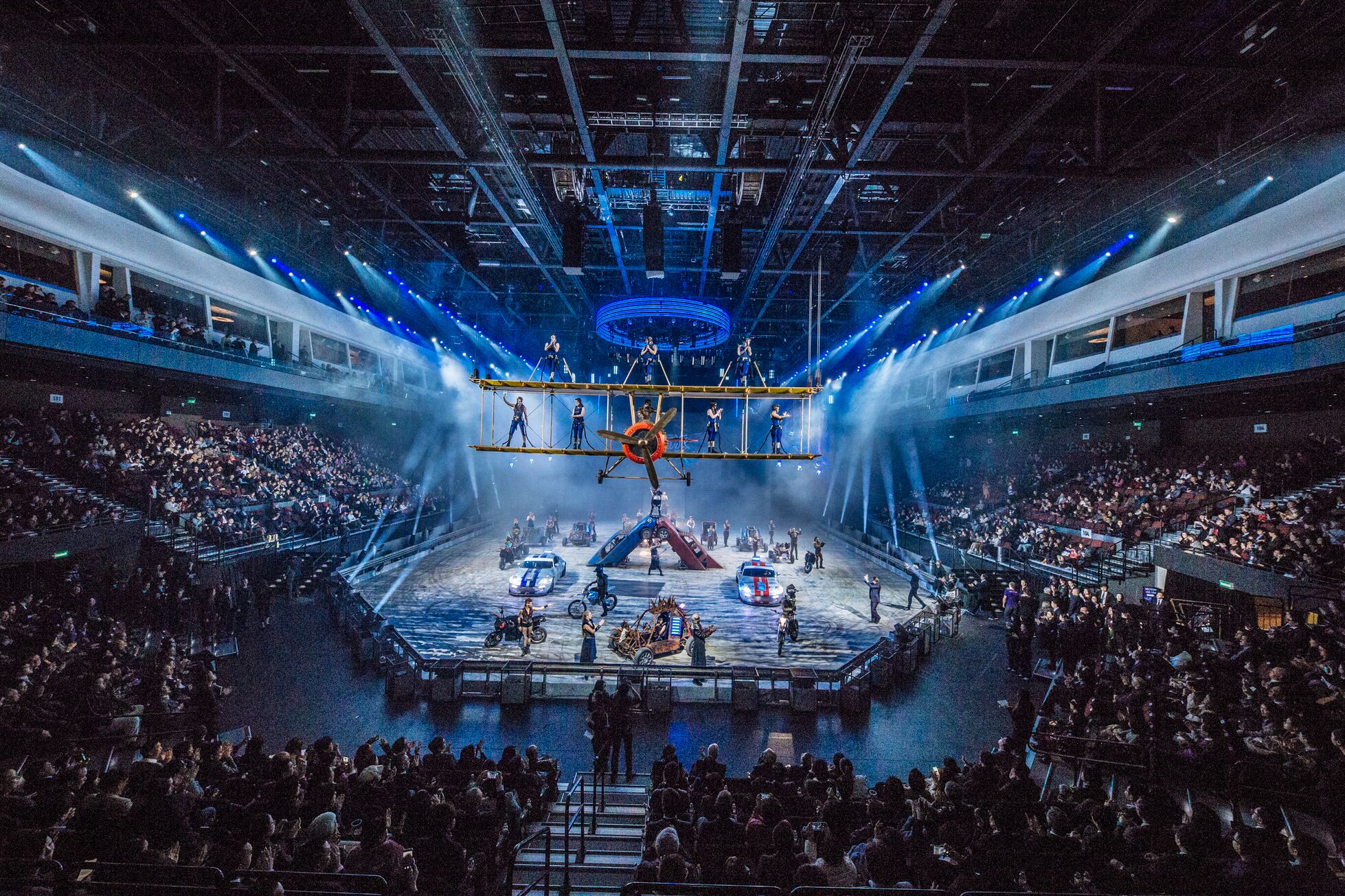
We had a dedicated team of mechanics who were all local Macanese staff, except for our British Head Mechanic, who had spent years of his life working and designing for Top Gear. This team of wizards was always ready for a race of their own. As soon as a call went out for them on headset, it took them only seconds to arrive at a sprint, repair-kits and towing gear at the ready. Usually, a bit of duct tape and re-wiring got us up and running again. Then, when everyone else rested from a long creation day, the mechanics team set to work and did in-depth repairs and testing to get all systems back in shape for another day of roaring excitement.
Four of us, myself included, went for Pre-hospital Trauma Life Support Training. All worries that we might not get enough chances to gain enough routine and experience were quickly set aside as we got far more practice than we had bargained for. As medical team, we would deal with our regular duties, until all of a sudden there would be a code yellow, orange, red, or black which meant we needed to first safely wrap up whatever else we had been in the process of coordinating backstage, so as not to cause a second accident due to rushing to the first one. We would then respond swiftly, don emergency PPE, and run to the scene of whatever had transpired, with spine boards, vehicle extraction kits, and medical bags. Thankfully, most accidents turned out to be minor, or at least didn’t lead to long-term physical impairments.
Throughout creation, it was as if we were creating two shows at the same time. One part was figuring out the choreography, timing, and traffic onstage. The other part was figuring out timing and traffic backstage. How could we get, let’s say, ten vehicles on stage, then off stage, whilst at the same time trying to get the other half of our vehicles on stage again. All this without missing a beat and without leaving the audience to stare at an empty arena during scene changes while we grappled to get everyone and their big electric guzzlers squeezed past each other, lined up, and ready.
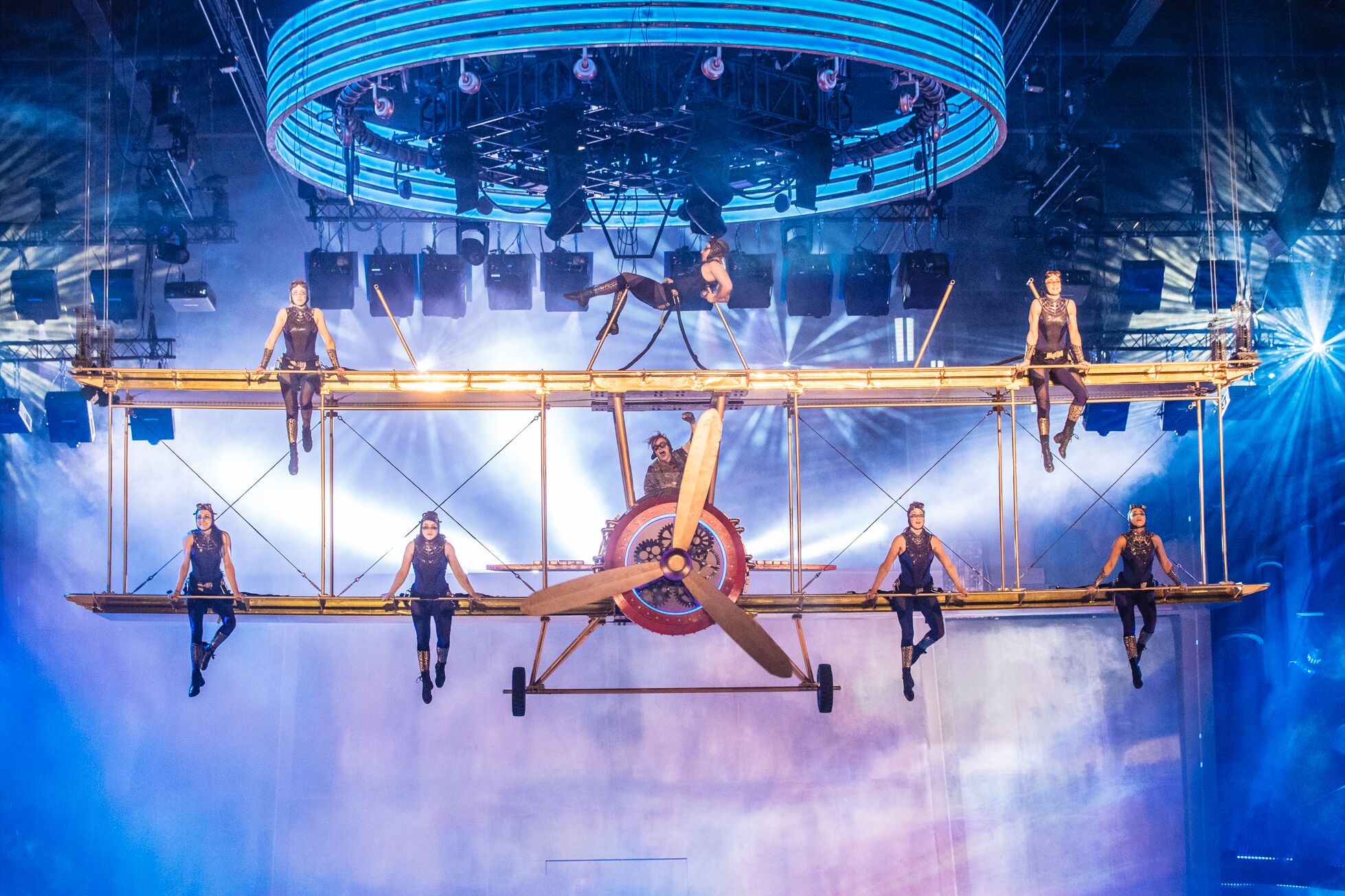
In the beginning, it was mayhem. As stage managers, we became traffic cops in the truest sense of the word, conducting a high-speed ballet with pimp-my-ride engines, performers, stage hands, and techs… all of them competing with each other for inches and seconds, to safely get to their cues in time for the next big moment.
Believe it or not, added to all the excitement on wheels, we had an even larger pallet of surprises in store for our audience. Whilst vehicles were speeding and flying all over the arena, following complex choreographies, aerial acts, fire acts, a crossbow act, parkour artists, dancers, and a brilliant pair of clowns were woven into the storyline, which… I guess… was more a zig zag bonanza of random, albeit brilliant, ideas than an actual line.
We had a fantastic team. International, too. Half of our eighty cast and crew were Mainland Chinese and Macanese, the other half was comprised of Brits, New Zealanders, Czechs, Portuguese, the odd German (me), two Finns, two Mexicans, two Canadians, one Belgian, and a couple other nationalities.
Many performers were young and not yet at the top of their game. Yet they made up for their inexperience with boundless enthusiasm, stamina, and the will to make the impossible possible. We did have some veteran performers as well. They were our main characters on stage, as well as taking over a sort of parent and mentor role backstage for the many individuals who had never done a show in their lives.
Despite things getting lost in translation, teamwork was excellent. At any point in time, we all had to stretch the horizons of our job descriptions and venture out of our comfort zones. All of us had to help with pushing props off stage when their wheels gave out under their weight. Or, to make our transitions on time, we would often have to help giving an extra push to stubborn set pieces which all of a sudden developed a life of their own. Lighting and sound techs became stage hands and stage hands assisted with lighting cues when needed. Stage managers did double (triple and quadruple) duty as stage hands, riggers, and mechanics. Follow-spot operators helped with arena cleaning duties, etc. The list was endless. It was pure joy seeing people working hand in hand like this, going the extra mile, beating the odds every single time, keeping afloat, and believing in delivering the best possible show together.
A typical track for me in stage management usually started with getting shot at by manic clowns brandishing popcorn canons. After chasing said clowns out of the arena during pre-show, I would end up winded, quickly catching my breath before needing to help strike a dust-riddled and cumbersome crimson red cinema curtain… which took my breath away once more.
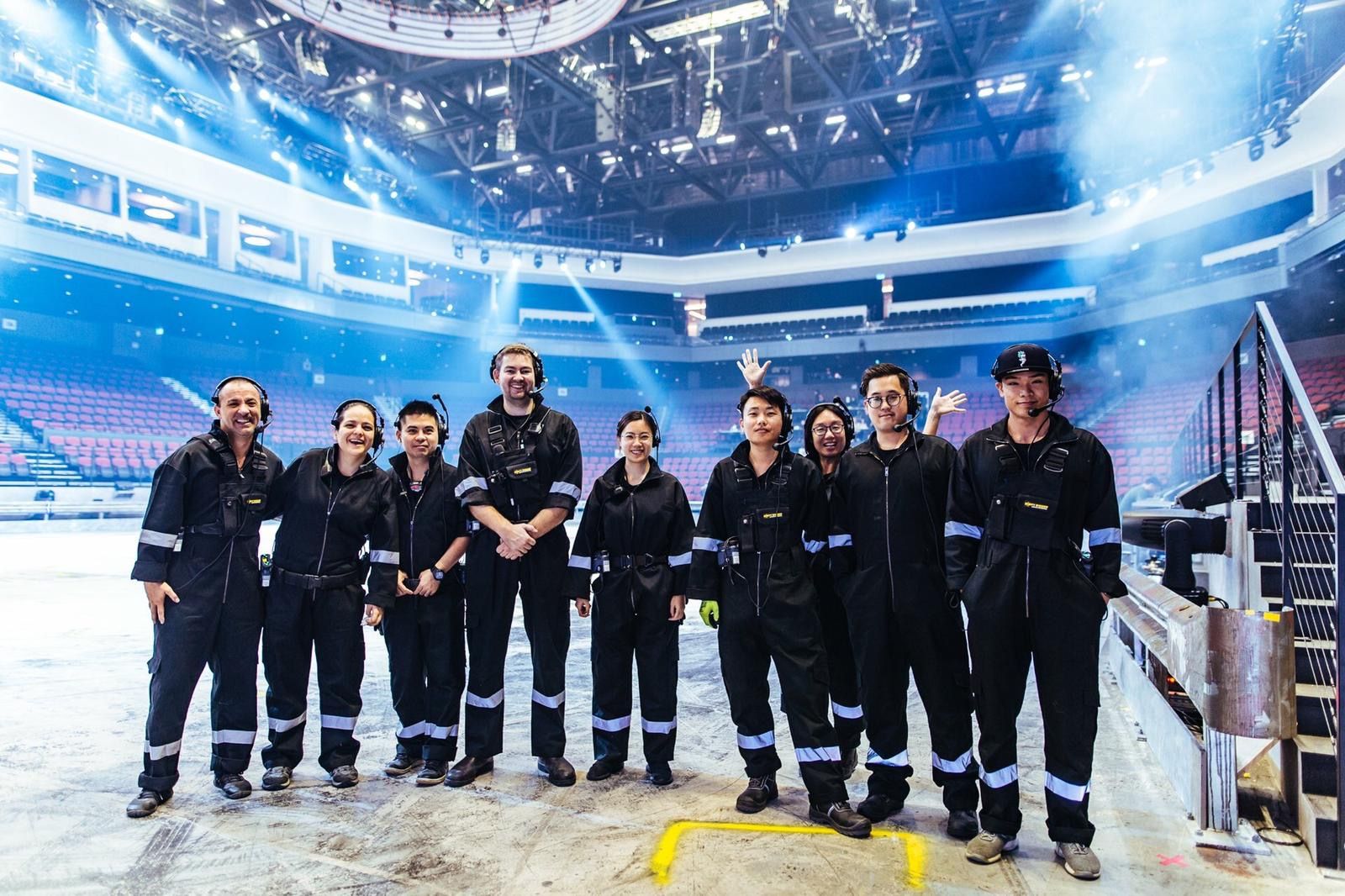
After a sip of water from a bottle hidden in a safe corner, I would manage to flush down a huge portion of the inhaled tire dust and un-glue my vocal chords. I would then help cue all riders and drivers to go on stage for scene one. From that moment on, the entire show would see me rushing (as calmly and controlled as possible under the circumstances) from one side of the arena to the other.
In between, I would be stationary for pivotal moments which required directing traffic. For scene three, I would quickly make my way up to the grid to be a five-minute rigger, clipping in performers who walked a hair-raising thirty meters down a vertical wall. I would then run downstairs as fast as my knees and feet would carry me, to do more traffic policing, and to cue whole lines of mad drivers and riders. One major challenge would be to keep our excited young performers from honking and turning their headlights on before going on stage.
Dripping sweat, high on adrenaline, I would then tap into energy reserves I didn’t even know I possessed to get ready for our pulling-out-all-the-stops finale. All cast and crew together would bring all vehicles and props onstage for a firework of human and mechanical movement, including performances such as jumping motorbikes, break dancers, almost naked clowns on surf boards, and even a party noodle truck and a full-sized biplane.
Now, just also imagine doing all this whilst following and listening to cues coming simultaneously from both a native show caller cueing all vehicle sequences in Mandarin and Cantonese, and an English-speaking show caller, managing all other cues.
Rarely was I this physically spent after a show. All backstage crew and stage management had to wear a fire-retardant boiler suit as standard show attire. Mine was dripping with sweat after each performance. You might have guessed from my account though – I loved every minute of it. I enjoyed how intensely physical this show was. How meetings, scheduling, line-up, and all the other usual admin suspects were balanced out by running full-on tracks during shows that brought me to the brink of exhaustion. I’ve never slept better.
Ours might not have been the most glamorous and perfect endeavor. Our show was rough around the edges, and still in need of touch-ups and maybe even a second creation. But we had heart. Our performances were carried by our unbridled enthusiasm. They were a potpourri of color, flying popcorn, and smoking tires, and they came alive with an atmosphere of joyfulness and audacity.
Unfortunately, the audiences did, over the long-term, not share our enthusiasm and ELĒKRŎN was shut down after only six months of operations. However, we did make it to show 150 (well, almost.. 149), a milestone we were all proud of. ELĒKRŎN, the first ever electrical vehicle stunt show in the world was, as the advertisements on every wall and bus in town had promised, a most electrifying show – and work experience. From start of creation in November 2018 to our last bow in July 2019, these were nine months of my life I’ll always fondly remember.
For just a little taste, check out this video on YouTube, filmed during our very last, fast and furious, bows. Everyone on stage together, saying goodbye to each other as well as to 2,500 spectators.
If you have a good Internet connection, make sure to watch it in HD quality with the volume turned up high!
Don’t Wear That Hat: Theatre Superstitions & their Origins
The Importance of Kindness in Entertainment
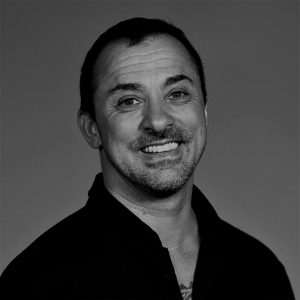

Liam Klenk was born in Central Europe and has since lived on four continents. Liam has always been engaged in creative pursuits, ranging from photography and graphic design, to writing short stories and poetry, to working in theatre and shows. In 2016, Liam published his first book and memoir, 'Paralian'.
Read Full Profile© 2021 TheatreArtLife. All rights reserved.

Thank you so much for reading, but you have now reached your free article limit for this month.
Our contributors are currently writing more articles for you to enjoy.
To keep reading, all you have to do is become a subscriber and then you can read unlimited articles anytime.
Your investment will help us continue to ignite connections across the globe in live entertainment and build this community for industry professionals.